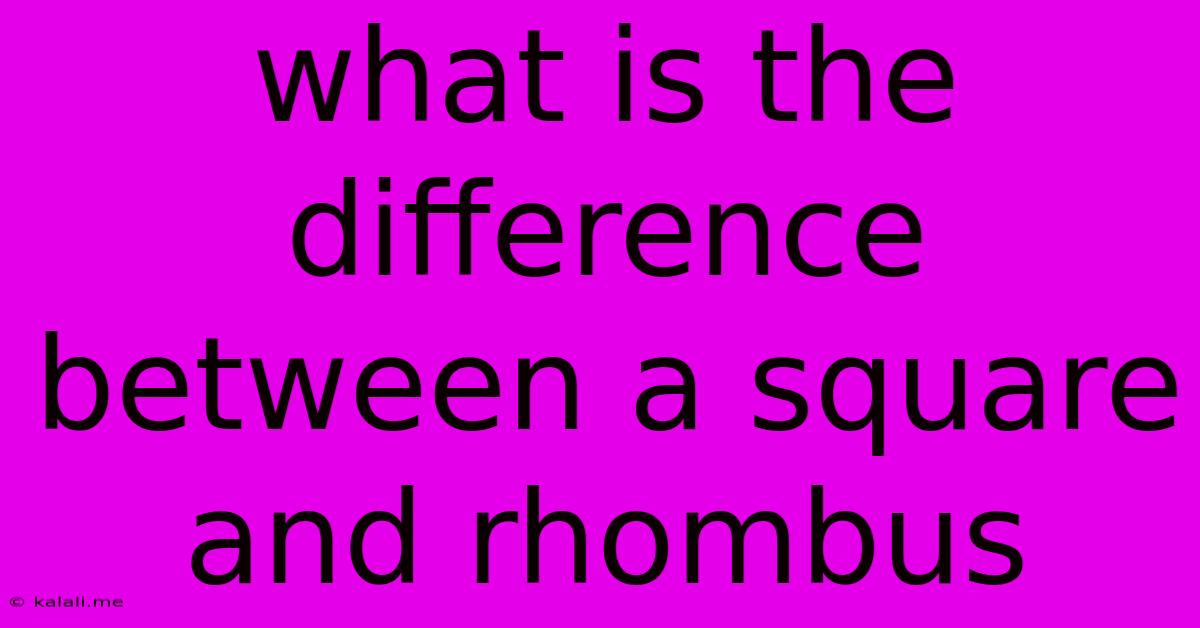What Is The Difference Between A Square And Rhombus
Kalali
Jun 14, 2025 · 2 min read

Table of Contents
Squares vs. Rhombuses: Unveiling the Geometric Differences
Squares and rhombuses are both quadrilaterals – four-sided polygons – sharing some similarities but possessing key differences. Understanding these distinctions is crucial for anyone studying geometry, from students to seasoned mathematicians. This article will clearly outline the characteristics of each shape and highlight what sets them apart.
What is a Square?
A square is a regular quadrilateral. This means all four of its sides are equal in length, and all four of its angles are equal, measuring 90 degrees each (right angles). Think of a perfect, evenly-proportioned box – that's a square in its purest form. Squares exhibit several important properties:
- Equilateral: All sides are of equal length.
- Equiangular: All angles are equal (90 degrees).
- Parallelogram: Opposite sides are parallel.
- Rectangle: Has four right angles.
What is a Rhombus?
A rhombus, also known as a diamond, is a quadrilateral where all four sides are of equal length. However, unlike a square, its angles aren't necessarily right angles. Imagine a square that's been "pushed over" – that's a rhombus. Key properties of a rhombus include:
- Equilateral: All sides are of equal length.
- Parallelogram: Opposite sides are parallel.
- Opposite angles are equal.
- Adjacent angles are supplementary (add up to 180 degrees).
The Key Differences: Where Squares and Rhombuses Diverge
The core difference lies in the angles:
-
Angle Measurement: A square always has four 90-degree angles. A rhombus can have angles of any measurement, as long as opposite angles are equal and adjacent angles are supplementary. This means a square is a special case of a rhombus.
-
Symmetry: While both shapes possess symmetry, a square exhibits more. A square has both rotational symmetry (can be rotated 90, 180, and 270 degrees and still look the same) and reflectional symmetry (can be reflected across multiple lines and still look the same). A rhombus only has rotational symmetry of 180 degrees and two lines of reflectional symmetry.
In Summary: The Venn Diagram Approach
Think of it like this: all squares are rhombuses, but not all rhombuses are squares. A square is a subset of rhombuses. This is best visualized using a Venn diagram. The circle representing squares would be entirely contained within the larger circle representing rhombuses.
| Feature | Square | Rhombus |
|---|---|---|
| Sides | 4 equal sides | 4 equal sides |
| Angles | 4 right angles (90 degrees) | Opposite angles equal, adjacent supplementary |
| Parallel Sides | Opposite sides are parallel | Opposite sides are parallel |
| Symmetry | Rotational and reflectional symmetry | Rotational (180 degrees) and reflectional |
Understanding these differences is key to mastering basic geometry. By grasping the nuances of squares and rhombuses, you'll build a stronger foundation for more complex geometric concepts.
Latest Posts
Latest Posts
-
University Of Kent Uk Acceptance Rate
Jun 14, 2025
-
Difference Between Primary Key And Unique Key
Jun 14, 2025
-
Which Of The Following Is A Landlocked Country
Jun 14, 2025
-
According To Machiavelli The Ideal Form Of Government Was
Jun 14, 2025
-
Average Act Score For University Of Minnesota
Jun 14, 2025
Related Post
Thank you for visiting our website which covers about What Is The Difference Between A Square And Rhombus . We hope the information provided has been useful to you. Feel free to contact us if you have any questions or need further assistance. See you next time and don't miss to bookmark.